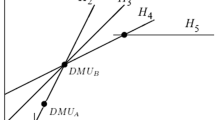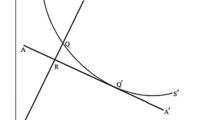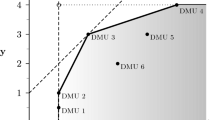Abstract
The traditional data envelopment analysis (DEA) models can be used for efficiency evaluation of decision making units (DMUs) with nonnegative data. However, in the real world there are DMUs which have negative inputs and/or outputs. Consequently, in the literature of DEA various approaches have been offered in order to deal with negative data. The current research proposes an algorithm concerned with a pure mathematical optimization method to measure hybrid efficiency of DMUs in the presence of negative data, and also a pure mathematical procedure for target setting. In doing so, explicit form equations of strong and weak defining hyperplanes of production possibility set (PPS) based on the multiple criteria decision making methodology are obtained. In characterizing these hyperplanes, a new multiple objective linear programming (MOLP) problem is presented whose feasible region of criterion space is similar to the PPS with variable returns to scale technology on nonnegative and negative data. The MOLP problem is solved using the multicriteria simplex method where its process of solving leads to construct all strong and weak defining hyperplanes. Then, using the strong and weak hyperplanes obtained and also without using any DEA optimization model, a hybrid measure of efficiency and a strong efficient target unit for each inefficient DMU with negative data are obtained. Finally, the results are discussed using two examples, where the first one, in detail, explains the proposed methods and algorithm, and the second one briefly shows the contributions are applicable for the real data.


Similar content being viewed by others
References
Afriat SN (1971) Theory of maxima and the method of Lagrange. SIAM J Appl Math 20:343–357
Ali AI, Seiford LM (1990) Translation-invariance in data envelopment analysis. Oper Res Lett 9:403–405
Allahyar M, Rostamy Malkhalifeh M (2015) Negative data in data envelopment analysis: efficiency analysis and estimating returns to scale. Comput Ind Eng 82:78–81
Amirteimoori A, Kordrostami S (2012) Generating strong defining hyperplanes of the production possibility set in data envelopment analysis. Appl Math Lett 25:605–609
Banker RD, Charnes A, Cooper WW (1984) Some models for estimating technical and scale inefficiencies in data envelopment analysis. Manag Sci 30:1078–1092
Bazaraa MS, Sherali HD, Shetty CM (2006) Nonlinear programming: theory and algorithms. Wiley, New York
Charnes A, Cooper WW, Golany B, Seiford LM, Stutz J (1985) Foundation of data envelopment analysis for Pareto–Koopmans efficient empirical production functions. J Econom 30:91–107
Charnes A, Cooper WW, Rhodes E (1978) Measuring the efficiency of decision-making. Eur J Oper Res 2:429–444
Charnes A, Cooper WW, Seiford LM, Stutz J (1983) Invariant multiplicative efficiency and piecewise Cobb-Douglas envelopments. Oper Res Lett 2:101–103
Cheng G, Zervopoulos P, Qian Z (2013) A variant of radial measure capable of dealing with negative inputs and outputs in data envelopment analysis. Eur J Oper Res 225:100–105
Cooper WW, Seiford LM, Tone K (2007) Introduction to data envelopment analysis and its uses with DEA-Solver software and references. Springer, New York
Doyle J, Green R (1993) Data envelopment analysis and multiple criteria decision making. Omega 21:713–715
Emrouznejad A, Anouze AL, Thanassoulis E (2010) A semi-oriented radial measure for measuring the efficiency of decision making units with negative data, using DEA. Eur J Oper Res 200:297–304
Fare R, Grosskopf S, Lovell CAK (1994) Production frontiers. Cambridge University Press, Cambridge
Forsund FR (2018) Economic interpretations of DEA. Soc Econ Plann Sci 61:9–15. https://doi.org/10.1016/j.seps.2017.03.004
Fukuyama H, Sekitani K (2012) Decomposing the efficient frontier of the DEA production possibility set into a smallest number of convex polyhedrons by mixed integer programming. Eur J Oper Res 221:165–174
Golany B (1988) An interactive MOLP procedure for the extension of DEA to effectiveness analysis. J Oper Res Soc 39:725–734
Hadi-Vencheh A, Jablonsky J, Esmaeilzadeh A (2015) The slack-based measure model based on supporting hyperplanes of production possibility set. Expert Syst Appl 42:6522–6529
Hosseinzadeh Lotfi F, Jahanshahloo GR, Mozzaffari MR, Gerami J (2011) Finding DEA-efficient hyperplanes using MOLP efficient faces. J Comput Appl Math 235:1227–1231
Hosseinzadeh Lotfi F, Noora AA, Jahanshahloo GR, Jablonsky J, Mozaffari MR, Gerami J (2009) An MOLP based procedure for finding efficient units in DEA models. Central Eur J Oper Res 17:1–11
Isermann H (1977) The enumeration of the set of all efficient solutions for a linear multiple objective program. Oper Res Q 28:711–725
Jahanshahloo GR, Hosseinzadeh Lotfi F, Akbarian D (2010) Finding weak defining hyperplanes of PPS of the BCC model. Appl Math Model 34:3321–3332
Kazemi Matin R, Amin GR, Emrouznejad A (2014) A modified semi-oriented radial measure for target setting with negative data. Measurement 54:152–158
Kazemi Matin R, Azizi R (2011) A two-phase approach for setting targets in DEA with negative data. Appl Math Model 35:5794–5803
Kazemi Matin R, Izadi Ghahfarokhi M (2013) A two-phase modified slack-based measure approach for efficiency measurement and target setting in data envelopment analysis with negative data. IMA J Manag Math 26:83–98
Kerstens K, Van de Woestyne I (2011) Negative data in DEA: a simple proportional distance function approach. J Oper Res Soc 62:1413–1419
Lovell CAK, Pastor JT (1995) Units invariant and translation invariant DEA models. Oper Res Lett 18:147–151
Murty KG (1983) Linear programming. Wiley, Toronto
Olesen OB, Petersen NC (1996) Indicators of Ill-conditioned data sets and model misspecification in data envelopment analysis: an extended facet approach. Manag Sci 42:205–219
Olesen OB, Petersen NC (2003) Identification and use of efficient faces and facets in DEA. J Prod Anal 20:323–360
Pastor JT (1996) Translation invariance in data envelopment analysis: a generalization. Annals Oper Res 66:91–102
Portela MCAS, Thanassoulis E, Simpson G (2004) Negative data in DEA: a directional distance approach applied to bank branches. J Oper Res Soc 55:1111–1121
Russell RR, Schworm W (2006) Efficiency measurement on convex polyhedral (DEA) technologies: an axiomatic approach. http://www.economics.adelaide.edu.au/workshops/doc/russell1.pdf
Scheel H (2001) Undesirable outputs in efficiency valuations. Eur J Oper Res 132:400–410
Sharp JA, Meng W, Liu W (2007) A modified slacks-based measure model for data envelopment analysis with natural negative outputs and inputs. J Oper Res Soc 58:1672–1677
Stewart TJ (1996) Relationships between data envelopment analysis and multicriteria decision analysis. J Oper Res Soc 47:654–665
Steuer RE (1986) Multiple criteria optimization: theory, computation, and application. Wiley, New York
Tone K (2001) A slacks-based measure of efficiency in data envelopment analysis. Eur J Oper Res 130:498–509
Yu G, Wei Q, Brockett P, Zhu L (1996) Construction of all DEA efficient surfaces of the production possibility set under the generalized data envelopment analysis model. Eur J Oper Res 95:491–510
Yu PL, Zeleny M (1975) The set of all nondominated solutions in linear cases and a multicriteria simplex method. J Math Anal Appl 49:430–468
Author information
Authors and Affiliations
Corresponding author
Rights and permissions
About this article
Cite this article
Ghazi, A., Hosseinzadeh Lotfi, F. & Sanei, M. Hybrid efficiency measurement and target setting based on identifying defining hyperplanes of the PPS with negative data. Oper Res Int J 20, 1055–1092 (2020). https://doi.org/10.1007/s12351-017-0362-1
Received:
Revised:
Accepted:
Published:
Issue Date:
DOI: https://doi.org/10.1007/s12351-017-0362-1




